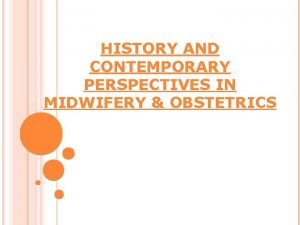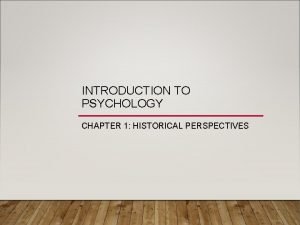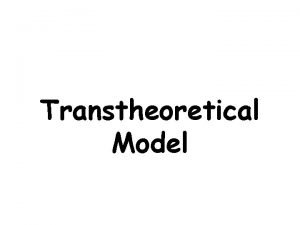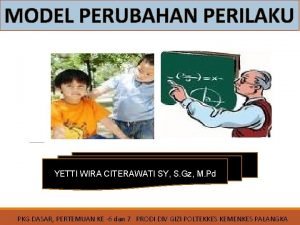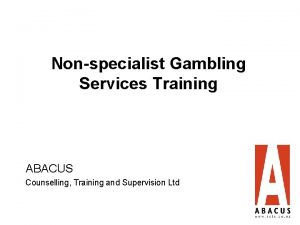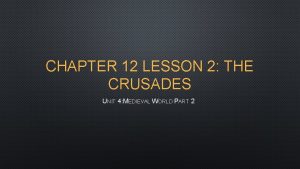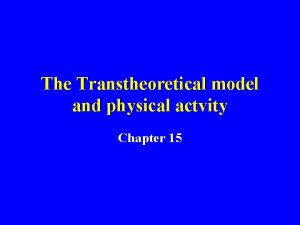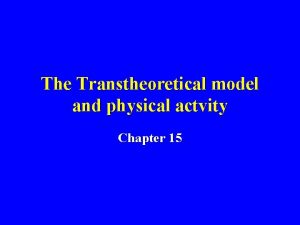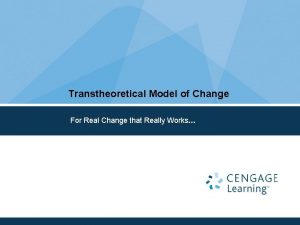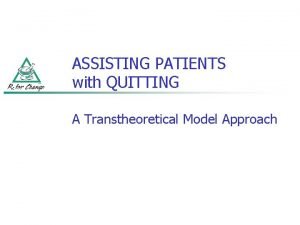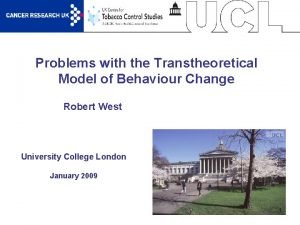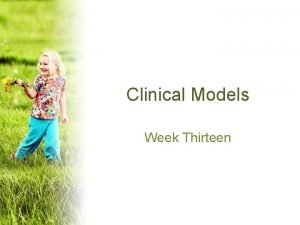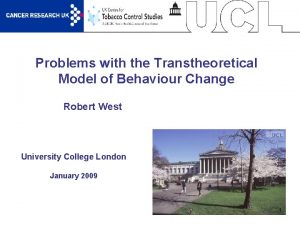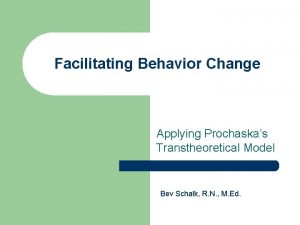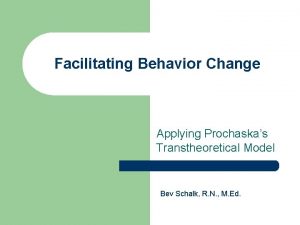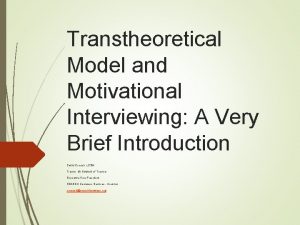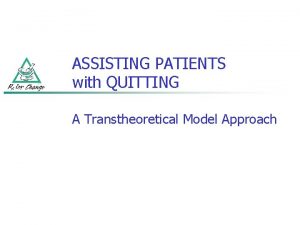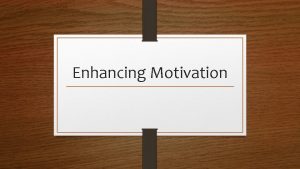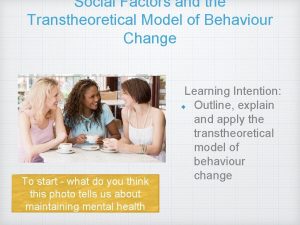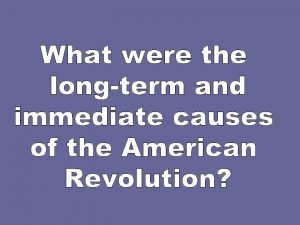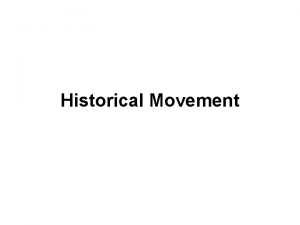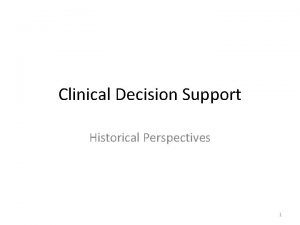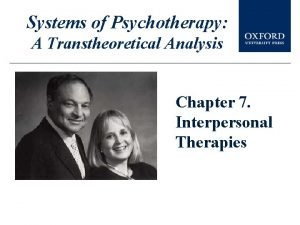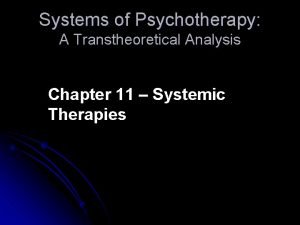CHAPTER 4 The Transtheoretical Model Historical Perspectives Late





































- Slides: 37

CHAPTER 4 The Transtheoretical Model

Historical Perspectives • Late 1970 s: James Prochaska from the University of Rhode Island undertook a task to review various theories behind psychotherapy • 1980 s: The University of Rhode Island Change Assessment (URICA) scale was developed • 1990 s: Two scales were developed on TTM – Readiness to Change Questionnaire (RCQ) – Stages of Change Readiness and Treatment Eagerness Scale (SOCRATES) • 2000 s: Variety of health applications • 2010 s: Health coaching & online applications • At present enjoys the status of being the most popular model

Stages of Behavior Change • • Precontemplation Contemplation Preparation Action Maintenance Termination General thumb rule: 40% precontemplation, 40% contemplation, 20% preparation © JPS/Shutterstock

Stages of Behavior Change Figure 4 -1: Stages of change in the transtheoretical model. The progression through the stages is not linear but cyclical or spiral; one might progress from precontemplation to action and then regress to contemplation and then again progress to action and so on.

Decisional Balance • Relative weighing of the pros and cons of changing • Pros: The benefits of changing – Janis and Mann (1977) identified the following components (recent work has found not much gain in predictive value): • Instrumental gains for self • Instrumental gains for others • Approval for self • Approval for others

Decisional Balance (cont’d) • Cons: The costs of changing – Janis and Mann (1977) identified the following components: • Instrumental costs to self • Instrumental costs to others • Disapproval from self • Disapproval from others

Self-Efficacy • Confidence – Behavior specific – Situation specific – “Here and now” – Build small steps © Olivier Le Moal/Shutterstock

Self-Efficacy (cont’d) • Temptation • Counteract stress • Avoid negative social occasions • Control cravings • Important in preparation and action stages © Creativa Images/Shutterstock

Consciousness Raising • Increased awareness of behavior • Experiential process – Methods • Feedback • Confrontations • Interpretations • Important in contemplation, preparation, and action stages

Dramatic Relief • Transition to emotional awareness • Experiential process – Psychodrama – Role playing – Personal testimony – Grieving © Andy Dean Photography/Shutterstock • Important in contemplation and preparation stages

Self-Reevaluation • Cognitive and affective assessment of one’s self-image • Experiential process – Value clarification – Healthy role modeling – Mental imagery • Important in preparation and action stages

Environmental Reevaluation • Affective and cognitive assessment of how one’s behavior affects the social environment • Experiential process – Empathy training – Documentary reflection • Important in contemplation, preparation, and action stages

Self-Liberation • Belief that one can change • Behavioral process • Commitment and recommitment – “Skill power” – Resolutions – Public testimony • Important in contemplation and preparation stages © Tashatuvango/Shutterstock

Helping Relationships • Caring, trust, openness, acceptance for behavior change • Behavioral process – Rapport building – Therapeutic alliance – Professional calls – Buddy systems • Important in action and maintenance stages

Counterconditioning • Learning of healthy coping • Behavioral process – Relaxation – Assertion – Desensitization – Nicotine replacement – Positive self statements • Important in preparation, action, and maintenance stages

Contingency Management • Consequences for taking steps in a particular direction • Behavioral process – Contingency contracts – Overt and covert reinforcements – Group recognition • Important in action and maintenance stages

Stimulus Control • Removes cues for unhealthy habits • Behavioral process – Avoidance – Environmental reengineering – Self-help groups © Kheng Guan Toh/Shutterstock • Important in action and maintenance stages

Social Liberation • Increase in social opportunities or alternatives • Experiential process – Smoke-free environment – Access to healthy alternatives • Important in action and maintenance stages

Stages & Processes of TTM Figure 4 -2: Relationship of the constructs and processes of the transtheoretical model to stages of change.

Five Phases for Planning Interventions 1. 2. 3. 4. 5. Recruitment phase Retention phase Progress phase Process phase Outcomes phase

Application of TTM to Smoking Cessation Figure 4 -3: Application of the transtheoretical model for a smoking cessation program.

Application of Stages of Change to a Physician Training Program: Four A’s • Ask • Systematically identify all smokers • Advise • Strongly advise smokers to quit • Determine patient’s willingness to make a quit attempt

Four A’s (cont’d) • Assist • Smoker patient to set a quit date • Prepare the patient for the quit date • Use nicotine replacement therapy or bupropion • Provide self-help materials • Arrange • Schedule follow-up contacts

Ask • Do you smoke? – Current • Did you ever smoke? – Former/never • How many cigarettes? • How long have you smoked? – Years • Reasons for smoking? • Benefits of quitting? – Swing the decisional balance in favor of “pros”

Advise • Clear – “I think it is important for you to quit smoking now and I know it will help you. ” – “Cutting down while you are ill is not enough. ” • Strong – “As your clinician, I need to let you know that quitting smoking is the most important thing you can do to protect your current and future health. ” • Personalized – Emphasize benefits of quitting at a personal level

Assist • Help the patient with a quit plan – Set a quit date (within 2 weeks). Patient must: • Inform family, friends, coworkers • Remove cigarettes from the environment • Review previous attempts • Anticipate challenges • Use nicotine replacement therapy or bupropion therapy as needed • Emphasize total abstinence

Arrange • Schedule follow-up contact – In person or via telephone • Timing – First must be soon after the quit date – Second follow-up at one month • Congratulate success • Attribute failures to external reasons and encourage another try; build self-efficacy

Population Impact of TTM • Population Impact (PI) = Participation Rate (PR) x Effectiveness Rate (ER) • For example, if 20% of the population of smokers participate in a stop smoking program and 30% of those who participate quit, then 6% of the smokers quit • Matching stage with process has been shown to increase both participation rates and effectiveness rates

Strengths of TTM • • Only theory to talk about behavior change Tested extensively Presents five stages of change Rooted in several theories of psychotherapy • Very elaborate © Sergey Nivens/Shutterstock

Some Limitations of TTM • Stages in the model are arbitrary, and to classify a population in different stages serves little utility – People can move through the stages of the model in minutes – The validity of self-reported behavior with regard to stage is questionable – A significant number of people cannot be assigned to recognized stages • Need to strive for parsimony of stage-matched behavior-specific processes

Some Limitations of TTM (cont’d) • Comparative studies of stagematched versus non-stagematched interventions are lacking • Applications to vulnerable subgroups of populations are lacking © Pockygallery/Shutterstock

Application Exercise • One TTM example is the development of a physical activity intervention, “Moms on the Move” (Fahrenwald, Atwood, Walker, Johnson, & Berg, 2004; Fahrenwald & Sharma, 2002), designed for women in the contemplation and preparation stages of physical activity behavior change. • Constructs used in the intervention were decisional balance, self-efficacy for physical activity, three behavioral processes (i. e. , selfliberation, helping relationships, and counterconditioning) and an experiential process (i. e. , environmental reevaluation).

Application Exercise (cont’d) • The primary delivery mode was providerdelivered counseling supplemented with an interactive brochure and four biweekly providerdelivered telephone contacts. • Using an experimental design, the authors were able to demonstrate statistically significant changes in TTM constructs and physical activity behavior. • Read the two articles and prepare a 250 -word critique.

Application Exercise (cont’d) • In your critique pay attention to: – Appropriateness of selection of constructs – Adequate operationalization of constructs in the instrument and intervention – Validity and reliability of instruments – Appropriateness of statistical analyses – Appropriateness of conclusions and ability to generalize the results

Websites to Explore • Applying TTM to Family Practice – http: //www. aafp. org/afp/2000/0301/p 1409. html • Applying TTM to Substance Abuse – http: //www. addictioneducation. co. uk/transtheoretical 2 001. pdf • Boston University: Webcast by Dr. James Prochaska – http: //cpr. bu. edu/resources/webcast/stages-of-change

Websites to Explore (cont’d) • Cancer Prevention Research Center (CPRC): Transtheoretical Model – http: //web. uri. edu/cprc/ • Transtheoretical Model: Pro Change – http: //www. prochange. com/transtheoretical-model-ofbehavior-change • University Of Maryland: Habits—Health & Addictive Behaviors: Investigating Transtheoretical Solutions – http: //www. umbc. edu/psyc/habits/

Skill Building Activity © Alexmillos/Shutterstock • Specific to your behavior, reflect on how you might assess the stage in which individuals in your target group might fall. • Identify learning activities (processes) for those at each stage of change. • How might you improve the population impact for your target group?
 History of midwifery ppt
History of midwifery ppt Historical perspectives of psychology
Historical perspectives of psychology Model transtheoretical
Model transtheoretical Prekontemplasi
Prekontemplasi Termination transtheoretical model
Termination transtheoretical model Transtheoretical model of behaviour change
Transtheoretical model of behaviour change Transtheoretical model of behaviour change
Transtheoretical model of behaviour change Nelson science perspectives 9 online textbook
Nelson science perspectives 9 online textbook Lesson 4 the late middle ages
Lesson 4 the late middle ages Hát kết hợp bộ gõ cơ thể
Hát kết hợp bộ gõ cơ thể Lp html
Lp html Bổ thể
Bổ thể Tỉ lệ cơ thể trẻ em
Tỉ lệ cơ thể trẻ em Chó sói
Chó sói Tư thế worms-breton
Tư thế worms-breton Chúa sống lại
Chúa sống lại Kể tên các môn thể thao
Kể tên các môn thể thao Thế nào là hệ số cao nhất
Thế nào là hệ số cao nhất Các châu lục và đại dương trên thế giới
Các châu lục và đại dương trên thế giới Công thức tính thế năng
Công thức tính thế năng Trời xanh đây là của chúng ta thể thơ
Trời xanh đây là của chúng ta thể thơ Cách giải mật thư tọa độ
Cách giải mật thư tọa độ Làm thế nào để 102-1=99
Làm thế nào để 102-1=99 Phản ứng thế ankan
Phản ứng thế ankan Các châu lục và đại dương trên thế giới
Các châu lục và đại dương trên thế giới Thơ thất ngôn tứ tuyệt đường luật
Thơ thất ngôn tứ tuyệt đường luật Quá trình desamine hóa có thể tạo ra
Quá trình desamine hóa có thể tạo ra Một số thể thơ truyền thống
Một số thể thơ truyền thống Cái miệng xinh xinh thế chỉ nói điều hay thôi
Cái miệng xinh xinh thế chỉ nói điều hay thôi Vẽ hình chiếu vuông góc của vật thể sau
Vẽ hình chiếu vuông góc của vật thể sau Nguyên nhân của sự mỏi cơ sinh 8
Nguyên nhân của sự mỏi cơ sinh 8 đặc điểm cơ thể của người tối cổ
đặc điểm cơ thể của người tối cổ Giọng cùng tên là
Giọng cùng tên là Vẽ hình chiếu đứng bằng cạnh của vật thể
Vẽ hình chiếu đứng bằng cạnh của vật thể Phối cảnh
Phối cảnh Thẻ vin
Thẻ vin đại từ thay thế
đại từ thay thế điện thế nghỉ
điện thế nghỉ
